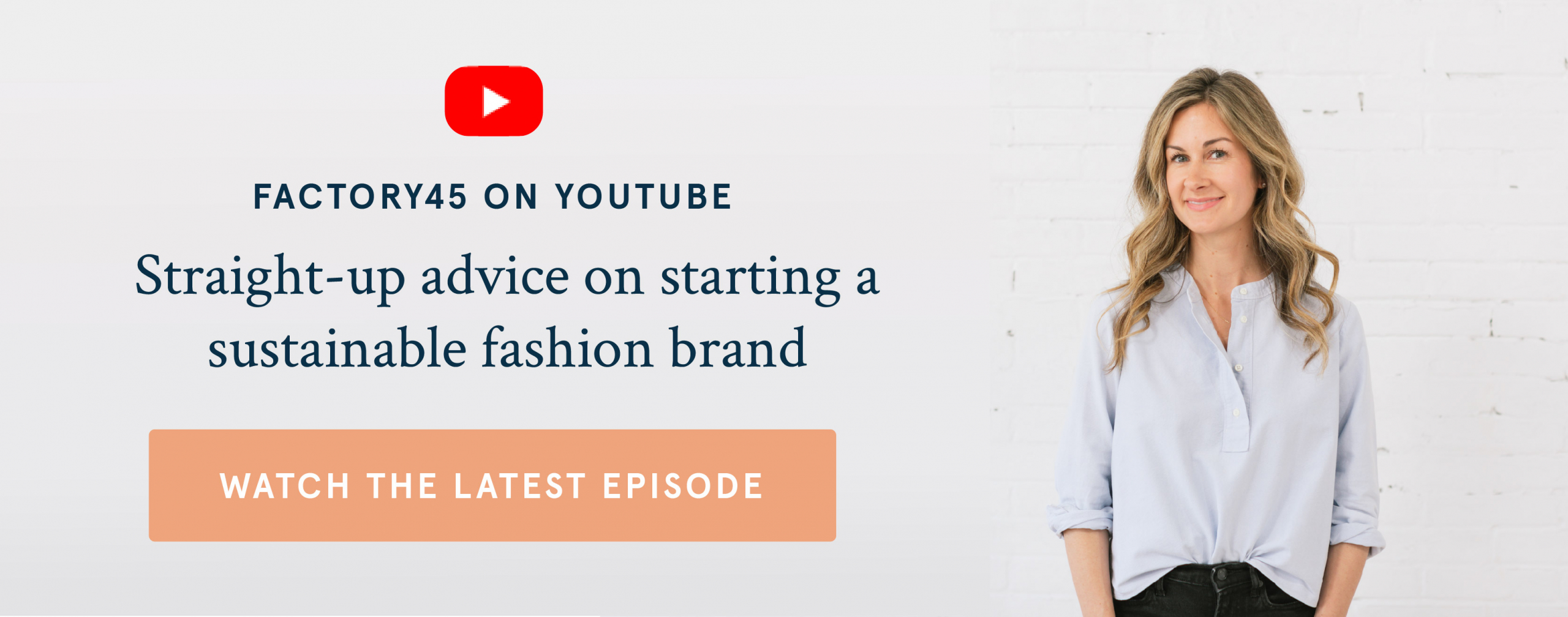Podcast Ep. 35: Why a Resale Strategy is the Next Sustainability Move for Fashion Brands
Listen on Apple Podcasts | Listen on Spotify
When you think about starting your own sustainable fashion brand there’s one thing you may be considering that traditional fashion brands aren’t thinking anything about… and it’s the end-life of the clothing you sell. In other words, when your customer is done wearing the garment they purchased from you, where will it end up? There are several different ways to approach the lifecycle of the clothing you’re selling but there’s one specifically that I want to highlight today. And for those of you who get ahead of the trend, it could mean another revenue stream for your business…
Resources mentioned in this episode:
Columbia Climate School article
TRANSCRIPT
When you think about starting your own sustainable fashion brand there’s one thing you may be considering that traditional fashion brands aren’t thinking anything about… and it’s the end-life of the clothing you sell. In other words, when your customer is done wearing the garment they purchased from you, where will it end up? There are several different ways to approach the lifecycle of the clothing you’re selling but there’s one specifically that I want to highlight today. And for those of you who get ahead of the trend, it could mean another revenue stream for your business…
I’ll start this episode with a depressing stat for you (depressing, that is, if you care about the planet). According to McKinsey, the fashion industry produced enough clothing in 2014 to provide nearly 14 individual items for every living person in the world.
And yeah, that was 2014 so there’s no question the number has increased since then. It’s no secret to those of us in the sustainable fashion industry, who have been speaking out against fast fashion for years (or in my case, a decade), that the industry is built around planned obsolescence.
In other words, the fashion industry wants you to feel out of trend so that you’ll continue buying more. In the case of the fast fashion industry, they want you to feel out of trend at the end of each week – that’s why there are now essentially 52 fashion seasons per year.
According to Forbes, in constantly pumping out a steady stream of new garments, the fashion “industry produces about 10 percent of global greenhouse gas emissions, uses more energy than the aviation and shipping industries combined and throws off 20% of global wastewater, all while being the second most water-intensive industry in the world.”
So, yeah.
But there is some good news. And a small spark of hope.
There is, of course, the sustainable fashion community. The smaller independent brands that are trying to change the industry from the inside out, educate consumers and spark conversations.
But there is also another group from the outside looking in – it’s a group of consumers who proudly identify as thrifters.
The idea of thrifting isn’t new. But in some ways, removing the stigma around thrift shopping is. Back in the 90s and early 2000’s, when I was a kid and then a teenager, I remember there being a negative connotation around buying secondhand clothing. If you shopped at Goodwill, for example, people assumed it was because you couldn’t afford clothes from the mall.
Nowadays, however, Forbes reports that 72% of consumers who think of themselves as thrifters are proud of it. In fact, “thrifting’s become such a thing that 41 percent of those who describe themselves as thrifters shop secondhand first, and they are passionate about it. Nearly half of consumers who bought secondhand clothing in 2021 bought ten or more used items.”
I’m definitely one of those people. I either buy secondhand from online resale sites or purchase from the brands we help to launch through Factory45. 99% of the clothing that my kids wear are either hand-me-downs or from Kidizen, a children’s resale clothing app.
The clothing resale company, Thredup, estimates that more than half of U.S. consumers either are or have the potential to become thrifters. Some 57% of consumers resold apparel in 2021 and more than half (53%) reported purchasing secondhand in 2021.
But here’s where it gets interesting for you, as the founder or future founder of a fashion brand.
Anthony Marino, the president of ThredUp, told Forbes that “Nearly 80% of the fashion and retail brand executives surveyed said their customers were already buying used.”
So that begs the question: “Do you have a resale strategy?”
Because it could be the growth opportunity you haven’t tapped into yet.
There are several different ways I could recommend doing this, but when you start to think about the end life or the lifecycle of your clothing brand – how can you potentially get creative with your own resale strategy?
Here are some different scenarios: It may look like partnering with a company like ThredUp, that already has an established system in place. It may look like creating your own Poshmark store and reselling gently used items that your customers can send back and get discounts on new items. Or it may look like a new section of your ecommerce or Shopify site where you have a gently used section for resale.
Whether you’re still in the idea stage of starting your brand, are getting ready to launch or have already been in business for a few years, the resale strategy is something to start thinking about now.
Marino goes on to tell Forbes: [quote] “It’s really smart for fashion brands to get ahead of the resale trends. They are at a fork in the road. They can either put their head in the sand or get started and learn. Retailers that get into resale will have a distinct advantage and increased wallet share by combining new items with used clothing in the same experience.“ [end quote]
And I must say, I tend to agree with him.
Before you go, I want to make sure you know we have a new free workshop available to you on how to Raise Money for Your Fashion Brand. If you don’t have a chunk of savings laying around to invest in a production run or the manufacturing of your fashion brand, then this workshop will be really helpful in suggesting some alternative options so starting your brand is less risky to you. The link in the show notes below or go to factory45.co/sustainable-fashion-event



